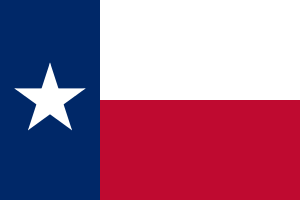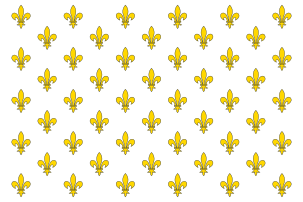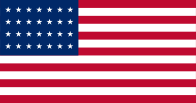Flag of Texas
 | |
| Name | The Lone Star Flag |
|---|---|
| Use | Civil and state flag |
| Proportion | 2:3 |
| Adopted |
January 25, 1839 Readopted: August 31, 1933 (De facto use between 1879-1933)[1] |
| Design | ⅓ of the hoist is blue containing a single centered white star. The remaining field is divided horizontally into a white and red bar. |
| Designed by | Unknown[2] |
The flag of the state of Texas is defined by law as follows:
The state flag is a rectangle that: (1) has a width to length ratio of two to three; and (2) contains: (A) one blue vertical stripe that has a width equal to one-third the length of the flag; (B) two equal horizontal stripes, the upper stripe white, the lower stripe red, each having a length equal to two-thirds the length of the flag; and (C) one white, regular five-pointed star: (i) located in the center of the blue stripe; (ii) oriented so that one point faces upward; and (iii) sized so that the diameter of a circle passing through the five points of the star is equal to three-fourths the width of the blue stripe.[3]
The Texas flag is known as the "Lone Star Flag" (giving rise to the state's nickname "The Lone Star State"). The current design of the flag was introduced to the Congress of the Republic of Texas on December 28, 1838, by Senator William H. Wharton,[1] was adopted on January 25, 1839, and eventually became the current state flag. The flag, flown at homes and businesses statewide, is highly popular among Texans and is treated with a great degree of reverence and esteem within Texas. In 2001, a survey conducted by the North American Vexillological Association rated the Texas state flag second best in design quality out of the 72 Canadian provincial, U.S. state, and U.S. territory flags ranked. The flag earned 8.13 out of 10 possible points.[4]
History and adoption

This flag was introduced to the Congress of the Republic of Texas on December 28, 1838, by Senator William H. Wharton[1] and was adopted on January 25, 1839, as the final national flag of the Republic of Texas.[1] When Texas became the 28th state of the Union on December 29, 1845, the national flag became the state flag. From 1879 until 1933 there was no official state flag, although the Lone Star remained the de facto state flag. The Revised Civil Statutes of 1879[5] repealed all statutes not explicitly renewed and since the statutes pertaining to the flag were not among those renewed, Texas was formally flagless until the passage of the Texas Flag Code in 1933.[1]
The actual designer of the flag is unknown.[1] Dr. Charles B. Stewart is credited with drawing the image used by the Third Congress when enacting the legislation adopting the flag,[6][7] and Sen. William H. Wharton introduced the flag to Congress.[1]
Colors and symbolism
The exact shades of red, white, and blue to be used in the flag are specified by Texas statute[8] to be the same as those of the flag of the United States, which are as follows:
| Color | Cable color | Pantone[9] | Web color[10] | RGB Values |
|---|---|---|---|---|
| Dark Red | 70180 | 193 C | #BF0A30 |
(191,10,48) |
| White | 70001 | Safe | #FFFFFF |
(255,255,255) |
| Royal Blue (traditional) | 70075 | 281 C | #002868 |
(0,40,104) |
The Texas Flag Code assigns the following symbolism to the colors of the Texas flag: blue stands for loyalty, white for purity, and red for bravery.[11] The code also states that single (lone) star "represents ALL of Texas and stands for our unity as one for God, State, and Country." The "lone star" is, in fact, an older symbol predating the flag which was used to symbolize Texans' solidarity in declaring independence from Mexico.[12] It is still seen today as a symbol of Texas' independent spirit, and gave rise to the state's official nickname "The Lone Star State."
The idea of the single red stripe and single white stripe actually dates back to the short-lived Republic of Fredonia, a small state near modern Nacogdoches which seceded from Mexico in 1826 before being forcibly re-integrated. The new state was formed through an alliance between local Anglo settlers and Native American tribes and the Fredonian flag used a white and red stripe to symbolize the two ethnic/racial groups from which the state was formed.[13] Though this rebellion ultimately failed it served as an inspiration to the later Texas Revolution.
Pledge of allegiance and flag protocol
.svg.png)
The pledge of allegiance to the state flag is as follows:
| “ | Honor the Texas flag; I pledge allegiance to thee, Texas, one state under God, one and indivisible.[14] | ” |
The pledge was instituted by the Texas Legislature in 1933, and originally referred to the "Texas flag of 1836" (which was the Burnet Flag, and not the Lone Star Flag then in use). In 1965, the error was corrected by deleting the words "of 1836." In 2007, the phrase "one state under God" was added.[14] The addition of "under God" has been challenged in court, though an injunction was denied.[15]
The flag is required by law to be displayed on or near the main administration building of each state institution during each state or national holiday, and on any special occasion of historical significance,[3] permanently above both doors of the Texas State Capitol, alone at the north door, and under the U.S. flag at the south door, with the exception being if the flags are at half mast or if the POW/MIA flag is being flown with the U.S. flag; in which event the Texas flag shall only fly at the North Door.[16] State law also requires that the state flag be flown at or near any International Port of Entry.[17] When displayed vertically, the blue stripe should be at top and, from the perspective of an observer, the white stripe should be to the left of the red stripe.[18]
Historical flags of Texas
National flags over Texas
-

1685–1689
French flag possibly used by René-Robert Cavelier, Sieur de La Salle, during the French colonization of Texas -

1690–1785
State flag and ensign of New Spain, also known as the Cross of Burgundy flag -
.svg.png)
1785–1820
Spanish state flag on land -
.svg.png)
1821–1823
Flag of the first Mexican Empire -
.svg.png)
1823–1836
First flag of the Mexican Republic, flown over soil claimed by Mexico until the Texas Revolution -
.svg.png)
1836–1839; 1839–1879
The "Burnet Flag," used from December 1836 to 1839 as the national flag of the Republic of Texas until it was replaced by the currently used "Lone Star Flag"; it was the de jure war flag from then until 1879[1] -

1839–1845/1846
Republic of Texas national flag from 1839-1845/1846 (identical to modern state flag) -

1845–1861, 1865–present
US flag in 1846 when Texas became part of the Union (for further US flags, see USA flag: Historical progression of designs) -
.svg.png)
1861–1865
CS flag in 1861 when Texas became a part of the Confederacy (for further CS flags, see CS flag: National flags)
- ^ "Flags of Texas". Handbook of Texas Online. Texas State Historical Association. Retrieved June 3, 2016.
Pre-Revolutionary Flags
-

Emerald flag of Augustus W. Magee and Bernardo Gutierrez's short-lived coup of 1812-1813
-

1816–17 – Used by Louis Michel Aury as Civil and Military Governor of Texas
-
.svg.png)
1817–21 – Used by pirate Jean Lafitte at Galveston Island
-

1819, The First uniquely Texan flag to predominantly feature a lone star.
-

Colonel James Long's flag – the second of the Texas flags with a Lone Star after the "Jane Long" flag
-

1826 – Flag of the Fredonian Rebellion
-

Purported flag of the Mexican state of Coahuila y Tejas, though the style and color of the stars are speculative.
Revolutionary flags
During revolutionary eras of Texas history, during the Spanish Texas period, Mexican Texas period, and the times of the Texas Revolution, a great number and variety of flags appeared.
-

The Come and Take It Flag – 1835 – This flag was used by Texas settlers at the Battle of Gonzales in October 1835
-

1835 – Flag Flown over the Goliad Declaration of Independence; possibly the "Bloody arm flag" reported to have accompanied the Dodson flag at the Texas Declaration of Independence
-

"The Alamo Flag" – 1835–1836 – Created in 1835, this flag was a reference to the Mexican constitution of 1824, in support of which the Texas rebels were fighting; supposedly flew at the Alamo
-

1836 – Brown Flag of Independence, possibly the "Bloody arm flag" reported to have accompanied the Dodson flag at the Texas Declaration of Independence
-

The Dodson Tricolor or the Dodson Flag - Designed and sewn by a Mrs. Sarah Dodson during the Revolution
-
.svg.png)
Flag designed by Stephen F. Austin between December 1835 and January 1836 while serving as a commissioner to the United States
-
.svg.png)
1836–1839; 1839–1879
The "Burnet Flag," used from 1836 to 1839 as the national flag of the Republic of Texas until it was replaced by the currently used "Lone Star Flag"; it was the de jure war flag from then until 1879. -
.svg.png)
1836–39 – The Lone Star and Stripes/Ensign of the First Texas Navy/War Ensign ; it was the de facto national flag between 1835-1839
-

The purported first official flag of the Republic of Texas, reportedly designed by Lorenzo de Zavala
-

Captain William Scott's Liberals carried this flag in the Battle of Concepcion on October 28, 1835
-

The flag under which the Georgia Battalion of Volunteers marched to Texas to participate in the fight against Mexico
-

Inspired by Gail Borden Jr., this flag was claimed to have been flown at the Battle of San Jacinto
-

Captain George H. Burroughs and company from Ohio came to Texas under this banner
-

The New Orleans Grays participated in driving the Mexicans from San Antonio and many were massacred at Goliad
-

The flag of the Red Rovers of Alabama who were massacred with Colonel James Fannin at the Battle of Goliad on March 27, 1836
-

San Jacinto Liberty Flag – The Sherman regiment carried this flag to victory at the decisive battle of San Jacinto
-

1840 – Republic of the Rio Grande, which claimed control over a large section of South Texas
The Lone Star and Stripes/Ensign of the First Texas Navy/War Ensign flag was widely used by both Texan land and naval forces. This flag was simply the United States flag with a Lone star in the canton. This flag echoes an earlier design, carried by the forces of James Long in failed 1819 and 1821 attempts to separate Texas from Spanish control. This earlier flag was exactly the same, save for the canton having a red background rather than blue. There is evidence that the Lone Star and Stripes was used at the battles of Goliad, the Alamo, and San Jacinto. Although interim President David Burnet issued a decree making the Lone Star and Stripes the first official flag of the Republic of Texas, it never became the legal national flag. It did remain the naval flag of Texas until annexation, and was noted for being "beneficial to our [Texan] Navy and Merchantmen" due to its resemblance to the U.S. flag. Despite its unofficial status, the flag remained well known inside the region and internationally as the symbol of Texas. The official blue and gold "Burnett Flag," on the other hand, was little known by Texans, and no contemporary illustrations of it have been discovered. An 1837 chart of national flags printed in Philadelphia showed the Lone Star and Stripes as the national flag of Texas, and Texas Senator Oliver Jones, who led the 1839 committee which approved the Lone Star Flag, was unaware that the Lone Star and Stripes was not the current official flag.[19] Later, prior to the American Civil War, this flag was carried by Floridian militiamen in Pensacola during the seizure of U.S. property in that city.
The "Come and Take It Flag" was created by the people of Gonzales, featuring the phrase, a black five pointed star, and the image of the town cannon Mexican forces had demanded they turn over. In March 1831, Juan Gomez, a Lieutenant in the Mexican Army, granted a small cannon to the colony of San Antonio. The small bronze cannon was received by the colony and signed for by Randy Tumlinson. It was then transported to Gonzales, Texas and later was the object of Texas pride. At the minor skirmish known as the Battle of Gonzales, a small group of Texans successfully resisted the Mexican forces who had orders to seize their cannon. As a symbol of defiance, the Texans had fashioned a flag containing the phrase along with a black star and an image of the cannon which they had received six years earlier from Mexican officials.
The so-called "Alamo Flag" or "1824 flag" was created by replacing the Eagle in the center of the Mexican tricolor with the year "1824," referencing the 1824 Constitution of Mexico, in support of which Texas was fighting. This was the first flag approved for use by rebel forces by a Texan legislative body. In 1835, the Texan provisional government approved the use of this flag for privateers preying on Mexican commerce. It has often been said that the 1824 flag was flown by Texan forces at the Battle of the Alamo. However, this was never alleged until 1860, long after the battle had occurred. Modern writers have pointed out that the presence of the 1824 flag at the time and place of the battle is highly unlikely. A similar flag was flown at least briefly by Texan Tejano forces, featuring two black, six pointed stars in place of the date. It is likely that the actual "Alamo flag" referred to by accounts of the time was the Lone Star and Stripes, which had been depicted in use at earlier battles such as Goliad, and was widely referred to as the "Texian flag."[20]
The Dodson Tricolor or Dodson flag was designed and sewn by a Mrs. Sarah Dodson during the Revolution. It resembled the flag of Revolutionary France, but with longer proportions and the Texan Lone Star in the canton. Stephen F. Austin was initially so alarmed by the obvious symbolism that he requested the flag not be used, but it nevertheless flew over Texan forces in Cibolo Creek, and may have been the first Texan flag raised over San Antonio. The flag was one of two that flew over the small cabin in which Texas delegates ratified their declaration of independence.
Republic of Texas flags
-
.svg.png)

 1836–1839; 1839–1879
1836–1839; 1839–1879 
The "Burnet Flag," used from 1836 to 1839 as the national flag of the Republic of Texas until it was replaced by the currently used "Lone Star Flag"; it was the de jure war flag from then until 1879 -
.svg.png)

 1836–1839
1836–1839
War ensign and de facto national flag between 1835–1839; replaced by the currently used "Lone Star Flag" upon its adoption; it was also the ensign of the First Texas Navy from 1836–1839, when it was officially replaced by the "Lone Star Flag" as the naval ensign -

1839–1845/6
The "Lone Star Flag," the Republic of Texas national flag from 1839-1845/6; official naval ensign for the Texas Navy from 1839 -
.svg.png)
1839–1845
Revenue Service Flag -
.svg.png)
1839–1845
Coasting Trader Ensign -
.png)
1839–1845
Pilot flag
The Burnet Flag was adopted by the Texan Congress on December 10, 1836. The name refers David G. Burnet, who was provisional president of the Republic of Texas when the flag was adopted.[1] It consisted of an azure background with a large golden star, inspired by the 1810 "Bonnie Blue Flag" of the Republic of West Florida.[21] Variants of the Burnet Flag with a white star, virtually identical to the Bonnie Blue Flag, were also common. Other variants featured the star (of either color) upside down, and/or ringed with the word TEXAS, with each letter filling one of the gaps of the star.
State flags over Texas
-

1824–1835
Flag of the State of Coahuila y Tejas in the Republic of Mexico -

1845–present
Flag of the State of Texas in the United States of America
Secession flags of Texas, 1861
In early 1861, between the secession of Texas from the US and its accession to the Confederacy, Texas flew an unofficial, variant flag of Texas with fifteen stars, representing the fifteen states. No drawings exist of the flag, there are only imprecise descriptions. The flag may have been based on the state flag or the Bonnie Blue Flag.[22]
-

Possible secession flag based on the state flag
-

Possible secession flag based on the Bonnie Blue Flag
Urban legend

It is a common urban legend that the Texas flag is the only state flag that is allowed to fly at the same height as the U.S. flag. Allegedly, Texas has this right inherently (as a former independent nation) or because it negotiated special provisions when it joined the Union (this version has been stated as fact on a PBS website).[23] However, the legend is false.[24] Neither the Joint Resolution for Annexing Texas to the United States nor the Ordinance of Annexation[25] contain any provisions regarding flags. According to the United States Flag Code, any state flag can be flown at the same height as the U.S. flag, but the U.S. flag should be on its right (the viewer's left). Consistent with the U.S. Flag Code, the Texas Flag Code specifies that the state flag should either be flown below the U.S. flag if on the same pole or at the same height as the U.S. flag if on separate poles.[11]
Similar flags
- Texas's flag is similar to the flag of Chile, first used in 1817. However, the Chilean flag has a blue canton with a white star rather than the entire left side being blue. The red bottom stripe begins below the canton. The Chilean Flag predates the Lone Star Flag by 22 years.[26]
- As shown above, the Republic of the Rio Grande flag was similar to Texas' only in that there were three stars with a red hoist, and black and white bars on the side instead of one star with a blue hoist and white and red bars. It is currently the flag of Laredo, Texas, its proposed capital.
- The flag of North Carolina is similar to the flag of Texas; North Carolina's flag has the same basic pattern as Texas's; however, the colors of the fly are reversed. In addition, the star in the hoist is smaller and is surrounded by scrolls and lettering. The Lone Star Flag predates North Carolina's current flag by 47 years.[27]
- The flag of Texas is quite similar to the "Flag of Céspedes" or "flag of La Demajagua," one of the two flags used during the Cuban War of Independence.[28]
Proposed Governor's flag

A proposed flag of the Governor of Texas consisted of the Seal of Texas centered on a field of azure. Like most U.S. gubernatorial flags, there were four five-point stars at the corners of the field. However, the Texas legislature failed to adopt this flag.
See also
References
- 1 2 3 4 5 6 7 8 Flags of Texas from the Handbook of Texas Online
- ↑ Vexillological Assn. of the State of Texas. "The Stewart Myth". Retrieved 2013-05-12.
- 1 2 "GOVERNMENT CODE CHAPTER 3100. STATE FLAG". state.tx.us. Retrieved 23 June 2015.
- ↑ "2001 State/Provincial Flag Survey". North American Vexillological Association. 2001. Archived from the original on 2015-02-08. Retrieved 2016-01-25.
- ↑ AL. "Revised Civil and Criminal Statutes of Texas, 1879". texas.gov. Retrieved 23 June 2015.
- ↑ Vexillological Assn. of the State of Texas. "The Stewart Myth". Retrieved 2013-05-12.
- ↑ [Stewart, Charles Bellinger Tate from the Handbook of Texas Online]
- ↑ "GOVERNMENT CODE CHAPTER 3100. STATE FLAG". state.tx.us. Retrieved 23 June 2015.
- ↑ The Pantone color equivalents for Old Glory Blue and Red are listed on U.S. Flag Facts at the U.S. Embassy's London site.
- ↑ The RGB color values are taken from the Pantone Color Finder at Pantone.com.
- 1 2 "GOVERNMENT CODE: CHAPTER 3100. STATE FLAG". State of Texas. 2001-09-01. Archived from the original on 2007-10-13. Retrieved 2007-10-21.
- ↑ Francaviglia, Richard V. (1996). The Shape of Texas: Maps as Metaphors. Texas A&M University Press. p. 80. ISBN 978-0-89096-664-8.
- ↑ Preble, George Henry; Asnis, Charles Edward (1917). Origin history American flag naval yacht-club signals, seals arms, principal national songs United States, chronicle symbols, standards, banners, flags ancient modern nations. Philadelphia: Central Press Co. p. 635.
- 1 2 "Pledge of allegiance to the state flag". Texas State Library and Archives Commission. State of Texas. 2007. Retrieved 2007-10-21.
- ↑ David Wallace Croft, "State Pledge."
- ↑ "GOVERNMENT CODE CHAPTER 443. STATE PRESERVATION BOARD". state.tx.us. Retrieved 23 June 2015.
- ↑ "TRANSPORTATION CODE CHAPTER 201. GENERAL PROVISIONS AND ADMINISTRATION". state.tx.us. Retrieved 23 June 2015.
- ↑ "GOVERNMENT CODE CHAPTER 3100. STATE FLAG". state.tx.us. Retrieved 23 June 2015.
- ↑ Maberry, Robert, Jr. (2001). Texas Flags. College Station: Texas A&M University Press. pp. 28–38. ISBN 978-1-58544-151-8.
- ↑ Maberry, Robert, Jr. (2001). Texas Flags. College Station: Texas A&M University Press. pp. 11, 26, 28–32. ISBN 978-1-58544-151-8.
- ↑ Allman, T.D. (2013). Finding Florida The True History of the Sunshine State (First ed.). New York: Atlantic Monthly Press. p. 63. ISBN 978-0-8021-2076-2.
- ↑ Kiel, Frank Wilson (January 2000). "A Fifteen-Star Texas Flag: A Banner Used at the Time of Secession: February 1861 and March 1861". The Southwestern Historical Quarterly. 103 (3): 356–365. Retrieved 27 February 2013.
- ↑ Texas English, from the "Do You Speak American?" series. Article by Jan Tillery and Guy Bailey of the University of Texas at San Antonio.
- ↑ "snopes.com: Texas Flag Flies at the Same Height as the U.S. Flag?". snopes.com. Retrieved 23 June 2015.
- ↑ "Ordinance of Annexation Approved by the Texas Convention on July 4, 1845 - TSLAC". state.tx.us. Retrieved 23 June 2015.
- ↑ C. Herndon Williams (7 May 2013). True Tales of the Texas Frontier: Eight Centuries of Adventure and Surprise. The History Press. pp. 60–. ISBN 978-1-62584-167-4.
- ↑ Texas flags. Texas A&M University Press. pp. 173–. ISBN 978-1-60344-369-2.
- ↑ Ignacio Ramonet; Fidel Castro (11 March 2008). Fidel Castro: My Life: A Spoken Autobiography. Simon and Schuster. pp. 144–. ISBN 978-1-4165-6250-4.
Further reading
- Gilbert, Charles (1989). Flags of Texas. Gretna, LA: Pelican Publishing. ISBN 0-88289-721-7.
- Kemp, L. W. (April 1956). "Official Flags of the Republic of Texas". Southwestern Historical Quarterly. 59 (4).
- Maberry, Robert, Jr. (2001). Texas Flags. College Station: Texas A&M University Press. ISBN 978-1-58544-151-8.
- Spain, Jr., Charles A. (February 1992). "Flags and Seals of Texas" (PDF). South Texas Law Review. 33 (1): 215–259.
External links
| Wikimedia Commons has media related to Flags of Texas. |
- Texas Flag Code
- Flags of Texas Independence Movements 1835-1836
- Historical Texas Flags
- Origin of the Lone Star Flag of Texas
- "Flags and Seals of Texas" by Charles A. Spain, Jr., South Texas Law Review
- Flags of Texas from the Handbook of Texas Online
- Flags of the Texas Revolution from the Handbook of Texas Online
- The Stewart Myth
- Official procedure for folding the flag of Texas
